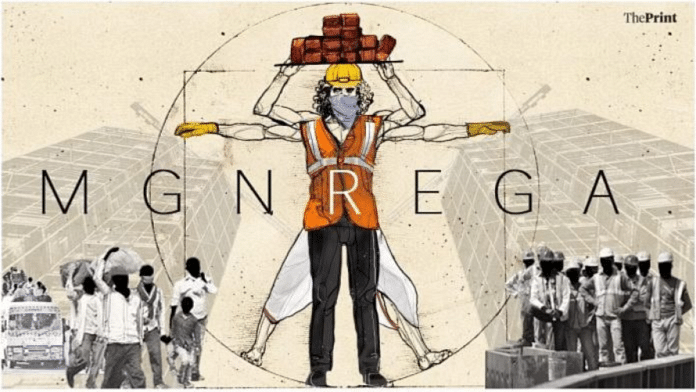New Delhi: The Narendra Modi government continued with its rural and tribal outreach with new initiatives and welfare schemes in the Union Budget 2024-25 tabled in Parliament Tuesday.
In the first budget of the Narendra Modi-led NDA government’s third consecutive term, Union Finance Minister Nirmala Sitharaman said that Rs 2.66 lakh crore have been allocated for rural development, including infrastructure such as all-weather road connectivity to 25,000 more rural habitations which have become eligible in view of their population increase.
For tribal areas, Sitharaman announced a new initiative, “Pradhan Mantri Janjati Unnat Gram Abhiyan”, for improving socio-economic conditions of tribal communities in tribal majority villages. “We will launch the ‘Pradhan Mantri Janjati Unnat Gram Abhiyan’ by adopting saturation coverage for tribal families in tribal-majority villages and aspirational districts. This will cover 63,000 villages benefitting five crore tribal people,” the finance minister said.
The announcement of the new initiative came months after the Modi government launched the Rs 24,000-crore “Pradhan Mantri Janjati Adivasi Nyaya Maha Abhiyan (PM-JANMAN)” in Khunti, Jharkhand, last November.
The PM-JANMAN scheme is aimed at providing basic services such as housing, roads, medical facilities etc. to the 75 Particular Vulnerable Tribal Groups (PVTGS) living in remote locations across the country.
In its first two terms, the Modi government launched several initiatives, including the “National Sickle Cell Anaemia Elimination Mission” and increasing the number of “Eklavya Model Residential Schools” to 740, to improve the socio-economic condition of tribal communities.
The Centre’s decision to allocate Rs 2.66 lakh crore for rural development, including infrastructure, has been welcomed by civil society members but they say that the budget doesn’t address other challenges.
Chakradhar Buddha, senior researcher at LibTech India, told ThePrint, “The allocation of Rs 2.66 lakh crore for rural development in the FY 2024-25 budget, which represents a 12 percent increase from last year, is a positive step. However, it still falls short of the ideal funding required to address the diverse and pressing needs of rural India. Considering the vast population residing in rural areas and the significant infrastructure and other challenges they face, a more substantial allocation, closer to Rs 8-10 lakh crore, would be necessary to ensure comprehensive and sustainable development. This increased funding would better reflect the needs for inflation-adjusted wages, enhanced infrastructure, and robust support for agricultural and livelihood programmes.”
Road & housing key focus areas
The finance minister announced a plan to launch Phase-IV of the “Pradhan Mantri Gram Sadak Yojana (PMGSY)” to provide all-weather connectivity to “25,000 rural habitations which have become eligible in view of their population increase”.
According to sources in the rural development ministry, approval will be sought from the Cabinet’s soon in this regard.
Phase-I of the PMGSY was launched in 2000 by then Prime Minister Atal Bihari Vajpayee-led NDA government. Till date, over seven lakh km of rural road network has been developed under the scheme covering over 1.62 lakh habitations.
In the interim budget, Sithraman had announced sanctioning of three crore houses under PMAY of which two crore would be in rural areas. The budget allocation for 2024-25 for PMAY-G is Rs 54,500 crore.
There was no mention of the “Mahatma Gandhi National Rural Employment Guarantee Scheme (MGNREGS)” in the budget speech. The allocation for the scheme (Rs 86,000 crore) remained the same as mentioned in the interim budget earlier this year.
According to the MGNREGA portal, total expenditure on the scheme was Rs 37, 407 crore till 23 July. As against 309.02 crore person-days generated in 2023-24, 113.62 crore person-days have been generated so far this year.
According to the Economic survey 2023-24, which was tabled in Parliament Monday, women’s participation in MGNREGA has increased in the past five years from 54.8 percent in 2019-20 to 58.9 percent in 2023-24.
The budget allocation for the scheme is not in-sync with the demand for work on the ground, especially with a large number of women seeking employment under the scheme. “In 2022-2023, the government spent about 90,000 crores on this scheme, even though it made abysmally low allocation. The government was forced to increase this expenditure due to rising demand for work for rural areas. In this budget, the scheme has been allocated 86,000 crores, which is Rs 4000 crores less than the actual expenditure of 2022-23,” the Left-affiliated All India Democratic Women’s Association (AIDWA) said in a statement.
(Edited by Tikli Basu)
Also read: Budget 2024: Funds, schemes for flood mitigation in Bihar, 4 other states






